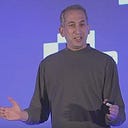Member-only story
What makes AR special?

I’ve spent the last 30 years working on XR, and the last twelve focusing on what’s so special about AR: what will we want or not want from it?
In 2008, I moved to Seattle (for the third time) and started working for Microsoft. I’d previously written blog posts about the problems we’d expect to find if anyone foolishly mashed up Second Life and Google Earth.
Some people were clamoring for this kind of Metaverse back then, where 3D avatars can roam around a virtual 3D planet. Having worked on both of those applications separately, I had reasons to believe a mashup was a bad idea.
It turns out, Microsoft had secretly tried to do this with a project called FirstLife. And it was having the problems I’d predicted. The leader of the project read my blog. He asked me to come help. Three months later, we’d totally re-imagined the design more like we’d today call the “AR Cloud.”
The key idea was to provide meaningful spatial intelligence to even 2D mobile apps so as to make our smartphones smarter about context, identity and place. “So-Lo-Mo” (social/local/mobile) was the closest idea around that time, but this went much farther IMHO with the spatial and personal aspects.
As big companies often do, the project was soon cancelled. The VP (my boss’ boss) famously told us “I don’t think mobile will be big.” And that was that.
I moved to the R&D wing of the company and helped kick off Avatar Kinect, Holographic Telepresence, a hundred different paper concepts. And then I moved over to XBox, Analog Labs, where we started HoloLens.
I had one more crack at the “AR Cloud” in 2011 when I lead a project called “Read/Write World.” That lead me to become the technical architect of a new effort to make Bing into a web-centric developer API along the same ideas: open, collaborative, spatial, etc… But it had its own issues and I finally left.
Fast forward to 2021 and everyone is talking Metaverse and how 3D is going to invade reality. I’m seriously getting “FirstLife” vibes all over again. I feel the need to speak up as I did before.
By 2021, I’ve had a chance to demonstrate (alas, in secret) many of my deeper concerns for AR, plus many of the best ideas I know — using the best hardware money can buy and…

